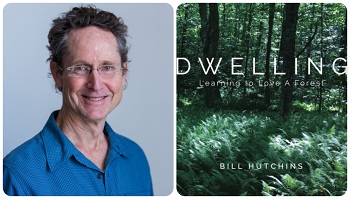The architect/poet talks about learning to love the forest.

After four decades spent living and working in the Washington, DC, area, architect Bill Hutchins and his wife relocated to her ancestral home in Vermont’s Green Mountain National Forest. It’s in that bucolic setting that Hutchins wrote his latest collection of poems and meditations, Dwelling: Learning to Love a Forest.
I know there’s a connection between your first and your latest published work. Could you explain?
My first book, Dwelling: A Poetic Exploration of Home, begins by fleshing out what dwelling means…The simplest way to explain dwelling is through images: I grew up body surfing, and I love being in the curl of the wave. This space is the union of mysterious forces moving across the ocean meeting land…A big teacher for me is the 13th-century Sufi mystic, Rumi. This one poem is the catalyst for the work I do, and it’s very short. It goes like this:
“There is a light grain seed inside.
You fill it with yourself, or it dies.
I’m caught in this curling energy of your hair.
Whoever is calm and sensible is insane!”
Every theology talks about a light-filled center, and that we are here to bring light into the world. So that’s the very seed of dwelling, the light grain seed. I did the same thing when writing Learning to Love a Forest. I went into the forest and opened myself up, listened, and engaged; I had no agenda. There are two primary ways: One, I go on ambles. I amble, listening for voices calling me. I write notes and engage in the dialogue. Then I come home, light a candle, and start writing. For me, a candle is another beautiful image of dwelling. A candle opens a space for something to come into this world, and it centers me. It’s highly intuitive and gives voice to whoever or whatever beings I was connecting with in the forest.
Do you have a philosophy of writing or living that informs your work?
As an architect, I put pen to paper and just start. I have no idea what is going to happen. I vividly remember one client — I had just begun sketching with them — and they looked at my hands exploring and said, “Wow, what’s going on?” Something happens when I open up and put the pen to paper, whether I’m drawing or writing a poem about a forest. It is the same process: I just open myself up to it and listen. It keeps deepening, and I collaborate with it, get the first layer down, then work with it more, then leave it alone, and then return. It’s very much like forming a relationship with a person: You open and give space at the same time and let things happen.
I’m smiling because this is something I learned from my artist father, this method of aimlessly putting pen to paper, which he got from the Swiss artist Paul Klee: “A drawing is simply a line going for a walk.” Maybe that’s why I’m attracted to your work — because we have similar inclinations about creative work. You told me this amazing story about the disorientation you experienced when you came back from a rafting trip. Can you share it here?
I love that story, too. In 2004, my wife, Beth, and I went on an extended rafting trip through the Grand Canyon. For 18 days, we never were indoors; 24 hours a day, we were outside. It was extremely hot, and the water cold, and it was this amazing, enlivening experience. We slept under the stars every night in the wilderness. There were no people other than just 10 of us. We finished on Native American tribal land. They came down with a school bus to pick us up and take us up to the main highway. For some reason, they took us to the back of a hotel and said, “Go through the hallway to the lobby to pick up the next bus.” The hallway…went on for about 50 feet. As soon as I entered, I was completely disoriented. In those 18 days, I returned to some primal way to be in the world. Then to enter this rigid Cartesian space, there was a huge teaching. And so my challenge as an architect is to create spaces that have some deeper relationship with the way that our bodies are in the world.
That Cartesian grid! This is a good segue into “the grove.”
The sacred grove is a remarkable story. There was a dirt road in front, and the [state of Vermont] wanted to build a two-lane highway adjacent to Beth’s family’s land. They needed gravel, and my wife’s great-grandparents allowed them to cut open the earth. The gouge is approximately 50 feet high by 90 feet wide by 200 feet long. They allowed the state to annihilate this hill. But Beth’s great-grandfather then planted white pine trees on a grid; it’s a childish grid, not absolutely perfect. The grove filled the entire space. Beth was 6 years old, and she and the grove have grown together. And now the trees are 60 feet tall! They’ve all taken root, and the space has been redeemed. It has an amazing presence; it is a spiritual space. It is quite a teaching: that as much as we’ve scarred the earth, we can redeem it or be part of the redemption. The sacred grove is not a disorienting space even though it’s on a Cartesian grid. It is in a middle realm between human artifice and natural. It is cathedral-esque since the Gothic cathedrals were modeled on the forest.
Jim Schulman is the executive director of the Alliance for Regional Cooperation, a nonprofit organization fostering sustainable regional economic development.

